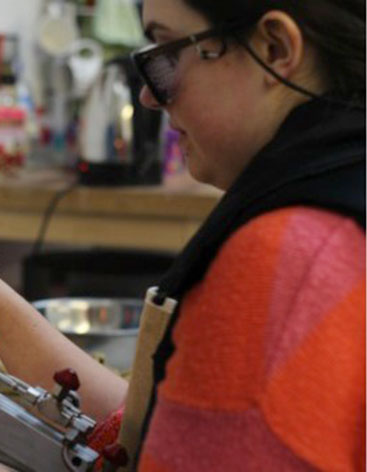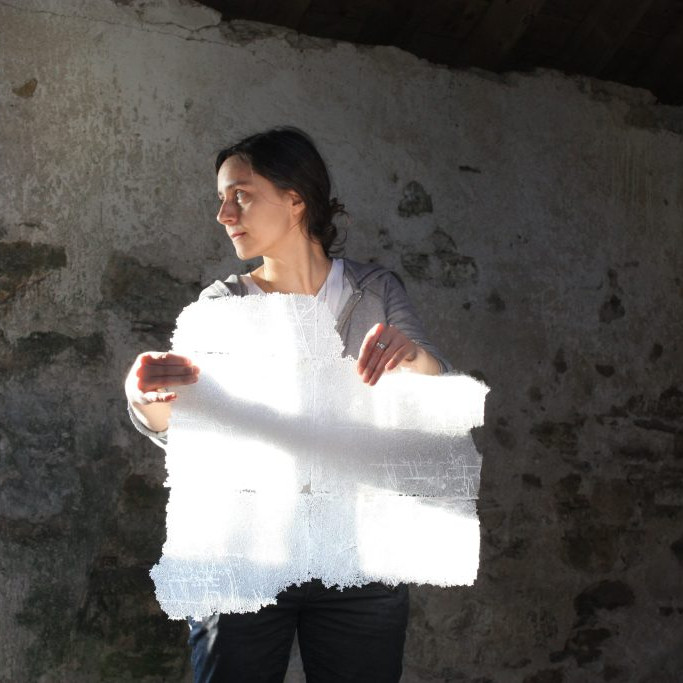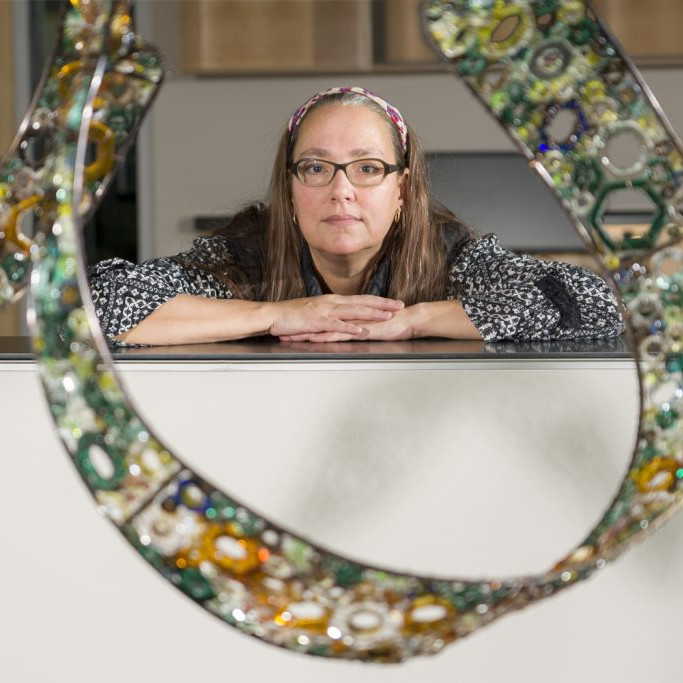Kathryn Baxter Glass Artist - Ipswich, UK
When and why did you decide that you wanted to work specifically with glass?
From an early age I had always collected small strange lamp work animals (the more deformed the better) and admired my Mum’s glass paper weight collection. I think it was the play of light and the mystery of how something could be encapsulated and which I couldn’t get to. For a child a few colourful swirls of glass could create a whole story.
Whilst studying Art and Design at Suffolk College in England I was taught how to cut and fuse sheets of glass. It was a fascinating process, from cutting a sharp cold piece of glass, putting it into a kiln to be fused and seeing how much the form had melted and altered after it had cooled. I’d never worked with such an unusual and unpredictable material.
I remember only finding a couple of photos from the college library showing glass as an art form, but it was amazing to see what could be achieved. Each piece looked magical.

Discuss how important doing such a specific degree in Glass and Ceramics has been to you?
Being given the advantage of being able learn a vast amount of different approaches and then having the opportunity to specialise completely opened up my creativity. Any idea I may have had brought with it the potential to be realised due to the wide-range of specialised knowledge and facilities at my disposal.
Studying at The University of Sunderland in the National Glass Centre gave me such a huge wealth of knowledge and experience which I could not have achieved from my own research. I was part of a team in which I was able to gain and share knowledge which I found to be greatly beneficial.
Discuss the importance of ventilation in your studio area?
Having a well-ventilated studio is incredibly important when Lampworking. As the glass rods are heated, toxic fumes are emitted which can be damaging to an individual’s lungs if not properly vented. It’s also important to make sure the Studio is getting a constant flow of fresh air to replace the fumes and oxygen which has been removed.
You have returned to Ipswich and set up a studio, Studio 4, with Emma Garnham, Fabiane Di Mascio and Bethany Jones. Can you discuss the collaboration and how it is working for you all?
Since joining Studio 4 I have been lucky enough to exhibit and sell my work alongside Emma Garnham and Fabiana Di Mascio as well as share a Studio.
There is such variety to all of our work Bethan Jones creates simplistic porcelain slip cast pieces, Fabiana focuses on abstract and encaustic paintings and Emma makes fragile and delicate pieces of pate de verre glass.
As all of our work differs so greatly we focus on our own artworks on a day to day basis but will come together for exhibitions and craft fairs.
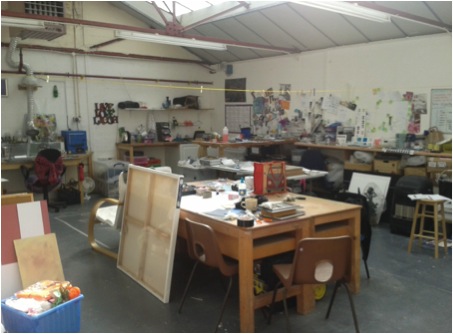
Photography by Emma Garnham
Can you take us inside Studio 4 and the various areas?
Studio 4 is now part of the Suffolk Open Studios scheme were the public can visit our studio and talk to us about our work.
The above image shows a section of our studio, in the centre of the room is a communal work space, on the right is Emma Garnham’s area and to the left of the image is my own work bench.
Can you discuss the combinations of colours you use?
I believe that colour plays a big part in expressing a mood or an emotion.
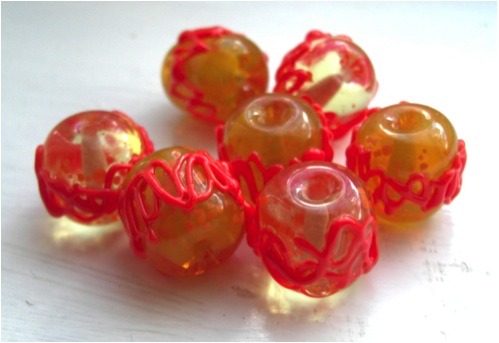
In reference to my lamp worked beads, I wanted to abandon the more controlled and perhaps restrictive concepts of some of my sculptural pieces. To do something fun and cheerful, and try to pass that on to others.
For example, last summer I created some light hearted seaside themed jewellery to sell to passers-by at a beach exhibition in order to capture and remind the wearer of the mood of that day.
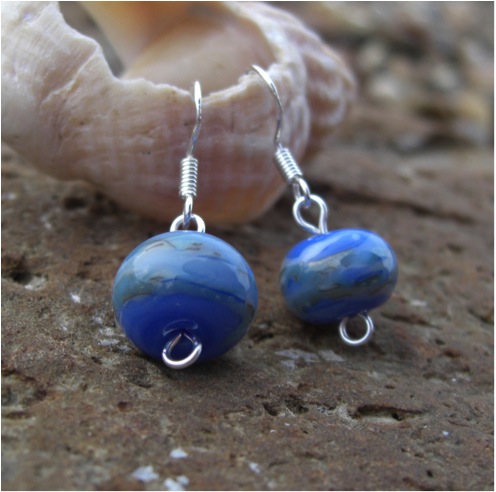
Please discuss your ‘Status Series’?
I have always enjoyed the crafting aspect of crochet. Whilst researching crochet and lace work I found in myself a desire to look into the ways in which crochet fits into communities and how it affects economy and lifestyle. These days crochet and knitting have been somewhat stigmatised, and are considered a pastime for the elderly, whereas several centuries ago it was valued highly, specifically lace work. I went on to look further into how individuals wear crochet, and how the clothing reflected their culture, and what wearing it meant in regards to reflecting wealth.
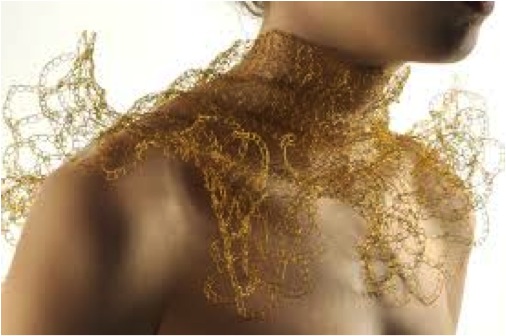
During my research I came across ruffs and collars, and was baffled by their comical nature. I found it almost ridiculous that something so eccentric could be so highly regarded in this historical community.
I wanted to combine my interest in crochet with the idea of the ever changing perceptions we have of particular objects, whilst integrating my glasswork. I realised that combining these two different approaches would create a contrast between what we see as an easily attainable and familiar craft in crochet, against a more highly sought after and valued material and skill in glass making.
I applied almost every technique I studied at university but I found by hot pouring the molten glass into a temporary steel frame there would be no stress on the core of the piece to remove the risk of the glass cracking and to control the amount of gases released from the wire, creating bubbles. It was my desire for the finished pieces to display with a sense of importance, hence “status”, so I had steel frames created to replicate the look of museum artefacts. In total there are five collars, each with a steel frame. They measure approx. 35cm x 50cm.
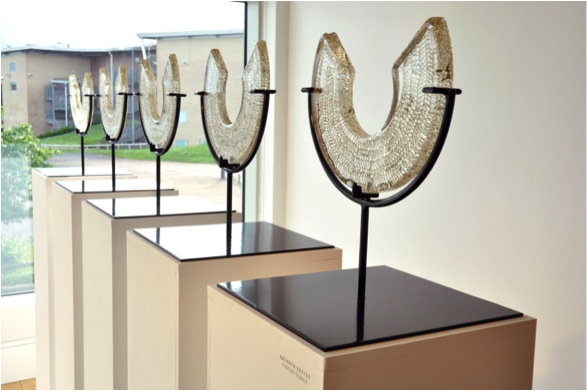
Can you explain the technique you have used in your work ‘Saturn’ and the inspiration behind it?
My fascination with space and astronomy has been passed down from my Dad and is something I’m always looking towards for inspiration.
I find the planet Saturn particularly beautiful and like the imagery of its orbiting ice rings. For this piece I wanted to capture the fifteen year cycle of the changing visual aspect of these rings. I used a water jet cutter to form the pieces and UV glue to adhere the components, turning the two dimensional shapes into a single three dimensional piece.
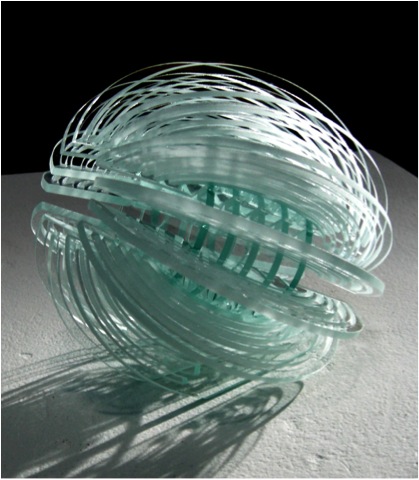
On a more traditional shape you have added a contemporary aspect in your ‘Pylon Series’. Please discuss?
For this piece I was inspired by the work of Australian-based artist Jeremy Lepisto. I liked the way in which he hand drew each image before applying them to his glassworks like a canvas.
As something of homage to this I hand drew scenery which was familiar to me to highlight the fact that even functional, industrial landscapes can look aesthetically pleasing.
I chose bright, bold colours to contrast and accentuate the stark black metals in the same way that its natural surroundings would in the English countryside.
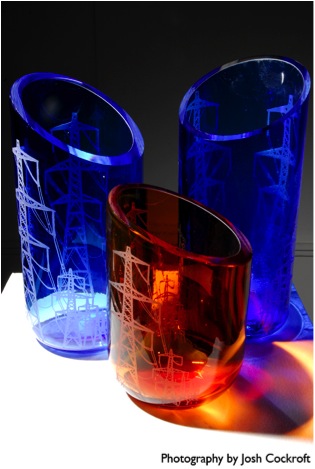
Can you expand on the size and placement of ‘Fluidity’
Fluidity was a series focusing on hot glass bubble sculpting and how location can affect a piece of work.
By placing my works in a pool of natural water I could create a sense of organic flow from the water through the glass, also emphasising the curvature of the piece, something of an ever present trait of my artwork.
The three pieces range from approx. 16cm-20cm in length.
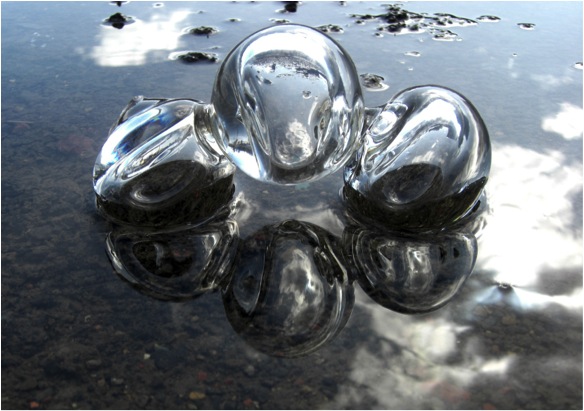
What are you currently working on?
Although I still enjoy creating sculptural pieces, for now I’m focusing my attention on my new lamp worked jewellery range, experimenting with colour and form. I like to see my jewellery pieces as personal, wearable artwork. I have a desire to create unique, high quality pieces which have unusual detail.
My new Chinese macramé inspired bracelets combine my interest in textured and soft fabric knot making with the contrast of smooth and transparent glass beads.
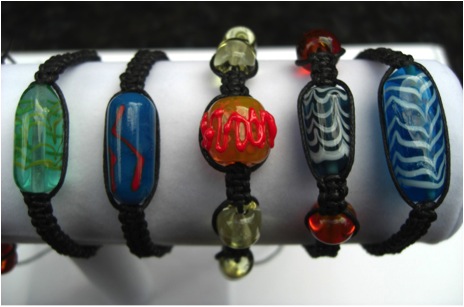
Contact details:
www.kathrynbaxter.co.uk
Kathryn Baxter, Ipswich, UK
Interview by Deborah Blakeley, May 2014
Think a colleague or friend could benefit from this interview?
Knowledge is one of the biggest assets in any business. So why not forward this on to your friends and colleagues so they too can start taking advantage of the insightful information the artist has given?
Other artists you may be interested in:


